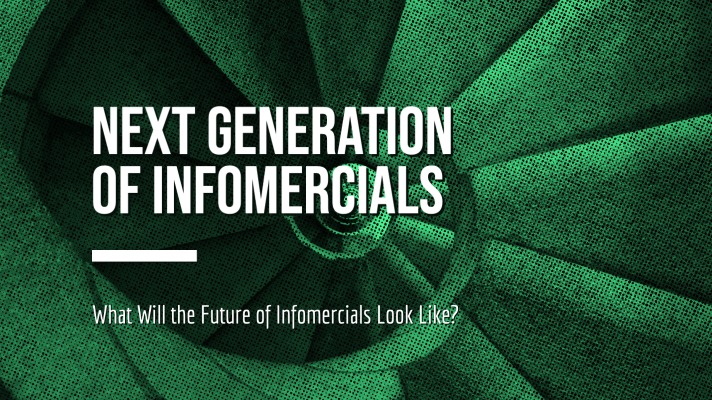Next Generation of Infomercials

What Will the Future of Infomercials Look Like?
What will the next generation of infomercials look like? What will they look like 10, 20, 30 years in the future? It is impossible to say exactly how they will change, as technology and society force the format to evolve. They will probably resemble today’s infomercials as much as the modern infomercial resembles those of 20 years ago. Which is to say, they are apt to look quite different, but the core sales messaging strategies are likely to be very similar.
Evolution
The modern-day infomercial looks very different from those of the past. The shows of today tend to be of higher quality than their predecessors. The days of corny pitchmen and actors who can’t seem to figure out basic technology like kitchen sponges are long gone. But today’s infomercials still follow many of the same formulas and precepts of their ancestors. Shows may feature more sophisticated animation and motion graphics. They might even employ drone footage or laser lighting. No matter how visually different they may present they are all still designed to do one thing above everything else… sell.
In order to predict the future of the infomercial, it is important to define what an infomercial is. To do that, we suggest taking a look back at the historical as well as the present format.
What is an Infomercial?
So first up, what is an infomercial? An infomercial is “paid programming,” typically a half-hour show-length advertisement. What really separates an infomercial out from a regular commercial other than length, is the call-to-action (CTA). A regular commercial can be a branding exercise as much as anything else. If you think for a moment, how often does a Coca Cola commercial actually ask you to buy a can of Coke, right now? Very rarely. Generally, they are just trying to get you to associate a positive feeling with Coke, so the next time you happen to be thirsty, you are thinking of the brand.
CTA
Infomercial CTAs, on the other hand, tend to be far more direct in trying to make an immediate sale. Generally, there is a phone number, website or text code so that a customer can either discover more information or make an immediate purchase. Because the sales are made directly from the company, this allows successful infomercials to fund themselves from the revenues of the sales. In essence, they are self-sustaining advertising with tracking and accountability similar to that of digital advertising.
History
The infomercial has gone by a few different names in its multi-decades existence, like Direct-to-Consumer (DTC), Direct Response (DRTV) and Performance Marketing. The name has occasionally changed to give the infomercial something of a more business-like appearance. This in itself is part of the evolution of the infomercial. The names have changed to better describe exactly how the form has evolved and works today.
Whatever name you call it, though, the infomercial had a history even before the television existed as a mainstream commercial product. In the early days of radio, full length shows would be sponsored by individual products, instead of having multiple ads for different companies placed throughout them like today. The shows were essentially half-hour commercials for a solitary product. This is where the term soap opera originated – daytime dramas aimed at housewives in the 1930s were frequently sponsored by dish soap companies.
The birth of television provided a perfect platform for the next stage of infomercials. This visual medium allowed for demonstrations far more impactful than anything radio could provide. Among the first infomercials that ever aired on television was the one for Vitamix blenders in 1950. It is a little on the simplistic side, but you can see basic elements that exist even in infomercials today. Vitamix company patriarch W.G. Barnard took you through a sales pitch on the blender. He demonstrated its ease of use and talks about its health benefits. At the end, there was a call-to-action to purchase the blender for a whopping $34.95. Given a modern Vitamix can go for well over 10 times that amount, what a bargain!
Fairly quickly, the Federal Communications Commission (FCC) cracked down on the length of time television stations could air advertising. This forced the infomercial to evolve, changing running time lengths and airing hours. During this period, the best-known infomercials were for products like greatest hits record sets and Shop Smith power tools. Still, Ginsu Knives managed to memorialize a meme that would forever affect infomercials with the phrase, “But wait! There’s more!”
The Golden Age
The infomercial evolved again in 1984 when the FCC lifted restrictions on advertising. This allowed for the proliferation of the half-hour long format, which in turn allowed for greater experimentation with segments designed to sell products. Demonstrations became more unique and could sit side by side with testimonials, man-on-the-street interviews and more. CTAs became more frictionless to prospective buyers, on higher priced products offering multiple installment payments.
As technology evolved, so did the infomercial. Shows began being produced in different sizes to fit on a variety of formats. Telephone ordering information exists with and sometimes has been replaced by URLs to microsites, or the instructions to text a code to a specific number for more information. The backend vendors servicing these infomercials became more sophisticated, mining more data for use in future products and marketing.
Today, infomercials are multimedia, multi-platform advertising products. While television is still an incredibly powerful medium, parts of a Direct-to-Consumer marketing plan live on the internet, on Over the Top (OTT) streaming platforms like Hulu and HBO Max, on radio – wherever your customers might be.
Conclusion
In conclusion, the next generation of infomercials is still going to include the basic sales elements that have been working to sell products since the invention of mass media. Elements like the demonstration and the testimonial are never going to go away. How they are presented will undoubtedly change. The devices they are watched on might not even have been invented yet. But as long as there are products and services that need to be sold and a visual mass-media platform to sell them on, the infomercial will always exist. Want additional thoughts? See “The New Era Infomercial” https://stsnext.com/the-new-era-infomercial/

